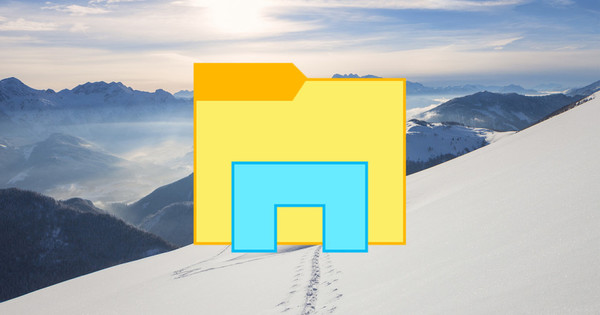The disk space of the partition where you installed Windows is running out. While there is still space on another partition. Can you enlarge the full partition? Yes, there are several options for that within Windows 10. We present three of them to you.
We assume the following situation: your system partition has become too small. In addition to the Windows folder, this will undoubtedly contain program and possibly data files. That is of course very annoying, because you can no longer install programs. It is even worse if it leads to an unworkably slow system and even to complete crashes. With a bit of luck you'll be able to overcome this problem quickly, even without extra tools. This is especially true if there is still plenty of unallocated disk space behind your system partition (presumably C).
It gets a little trickier, but not impossible, if there's a data partition behind your C partition (often the D drive). In that case, it is necessary to grab the required free space from the data partition and allocate it to your C partition. You can also mount the unallocated disk space to your C partition. Finally, there is the scenario where your disk is simply too small. Then all that remains is the option to transfer your disk – or at least the operating system – to a larger copy.
Before we juggle disk partitions, it's important that you back up your current partition. If something goes wrong, you can always go back to the old situation.
Increase partition with Unallocated space
Once the precautions have been taken, you can begin the delicate partition work. We'll start with the simplest scenario. Immediately behind your C partition, there may be unallocated disk space. To map the exact situation, press Windows key+R and enter diskmgmt.msc from. At the bottom you get a graphical representation of the disk utilization.
Immediately behind your C-partition, you notice a black section called ‘Unassigned' then you're fine. Right click on your C partition and choose Expand volume. Press Next one, select the same disc and confirm with Add. Bee Select the amount of space in MB indicate how much free disk space you want to add to the C partition. Press Next one and Complete. Moments later, your system partition lives on a bigger scale.

Shrink partition
Another scenario: you want to increase the size of your C partition, but your D partition has taken the remaining disk space. Then you have to shrink the D partition first in order to then be able to donate the freed space to your C partition.
To shrink the D partition, you still address the built-in disk management. Of course, there must be enough free space available on that partition. Right click on the D partition and choose Reduce volume. Fill in the field Specify how many MB to shrink the partition by and confirm with shrink.
You now have a C partition, followed by a D partition, followed in turn by Unallocated disk space. Unfortunately, we can't do anything with that in Windows Disk Management. We therefore pick up the thread with a more flexible tool and as far as we are concerned that will be the free MiniTool Partition Wizard Free.
Using MiniTool Partition Wizard Free
During the installation, make sure that you do not install any unwanted extras. After this, start the tool and click Launch Application. A textual and graphical overview of the disk utilization appears. You now actually have two options, which ultimately lead to the same result. The easiest way may be the following.
Right-click in either overview on your C-partition and choose Extend (to expand). Bee Take Free Space from choose the unallocated disk part, something like x[Unallocated]. Move the slider to the far right here if you want to claim all available space.

If everything looks good, press OK. You can find the requested action at the bottom left, at Operations Pending. Press Apply and confirm with yes to implement it effectively.
There is another method. Right click on your D partition and choose Move/Resize. Drag the right arrow button all the way to the end of the Unallocated space, then drag the left arrow button (which marks the beginning of your D partition) to the right. You do this until enough space becomes available for your C-partition.
Then you start for the C partition as described: choose Extend and mark the vacant space. You can then confirm both operations with Apply and with yes.
Dive deeper into Windows 10 and take control of the operating system with our Tech Academy. Check the Windows 10 Management online course or go for the Windows 10 Management bundle including technique and practice book.
Transfer Windows to New Disk
On to a third and a bit more difficult scenario: your current disk is really on the tight side and you can hardly extract disk space from it. There is then little choice but to purchase an additional, larger and perhaps faster (ssd) disk.
We assume that it is a SATA drive and you can probably hang it on a free SATA connector and power cable. On a laptop, you can temporarily mount the second drive as an external drive via a USB-to-Sata adapter. Then reboot your PC so that MiniTool Partition Wizard detects both drives correctly.

In the wizard window, choose Migrate OS to SSD/HD Wizard. click on Next and mark the (system) drive you wish to transfer. You may want the option I . here would like to replace my system disk with another hard disk Selecting. In that case, the MiniTool Partition Wizard will transfer all the partitions on your system drive and not just those that the operating system absolutely needs.
click on Next and indicate the extra disk. Keep in mind that this operation will irreversibly erase any existing data on the target disk. Confirm your choice with Next and with yes.
Normally, an extra dialog box opens, in which you get two choices. You can choose Copy partitions without resizing. This keeps the partitions of your original disk the exact size. That doesn't seem optimal to us, because you still have to expand the system partition on the target disk.
The better choice seems to us Fit partitions to entire disk. By default, this will expand all partitions on your original disk proportionally until all space on the target disk is used. From the same dialog you can make sure that, for example, only your system partition is allocated more space and any remaining Unallocated space is contiguous and exclusively at the back of the drive.

The check mark at Align partitions to 1 MB do your best. Note that the free version only allows you to perform an operating system migration between drives with the same partition style (mbr or gpt). The paid pro variant still allows such a conversion ($59). Confirm with Next, Finish, Apply and again with yes.
You may now receive a message that the (system) disk is in use. Then you choose Restart now, so that the tool can continue the procedure after a restart. Or you can purchase the pro version. This allows you to create a boot medium with which you start the PC. From here you can perform the transfer operation without reboot.
Once everything has been completed properly, you can replace your original drive with the other one. Or you can set the bios in such a way that the PC will start from that extra disk from now on. Now you have enough space to store files and install software!

